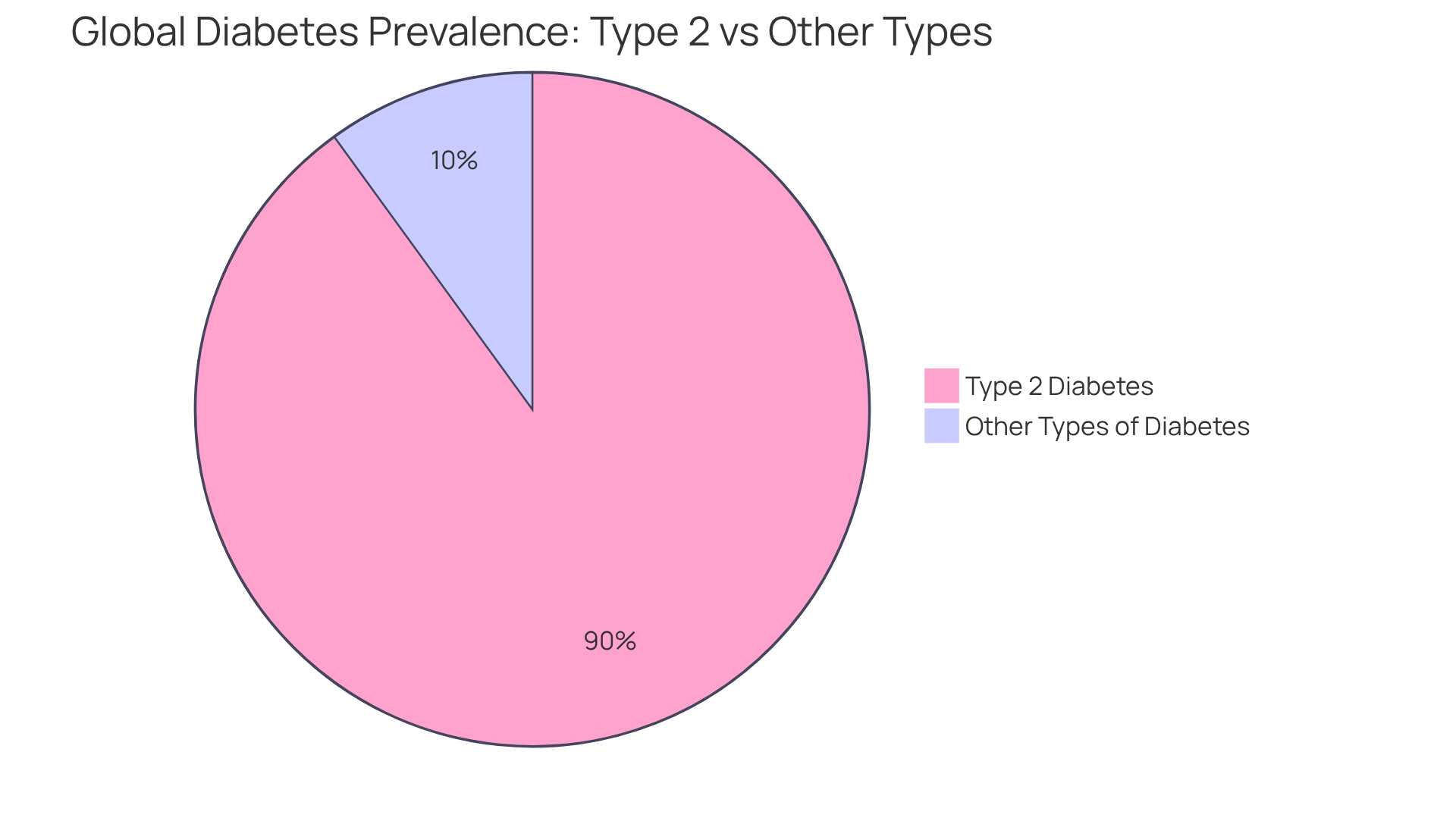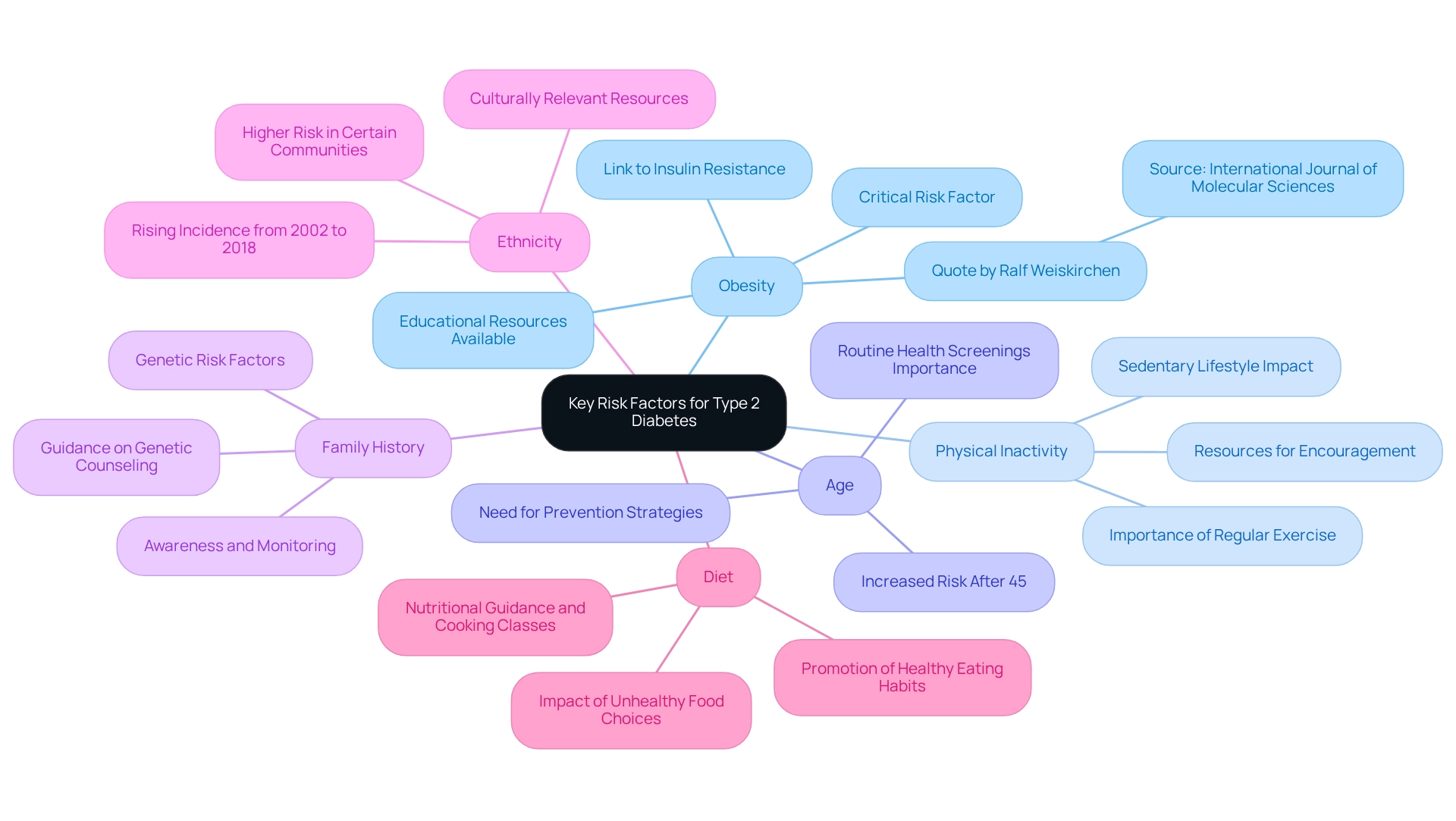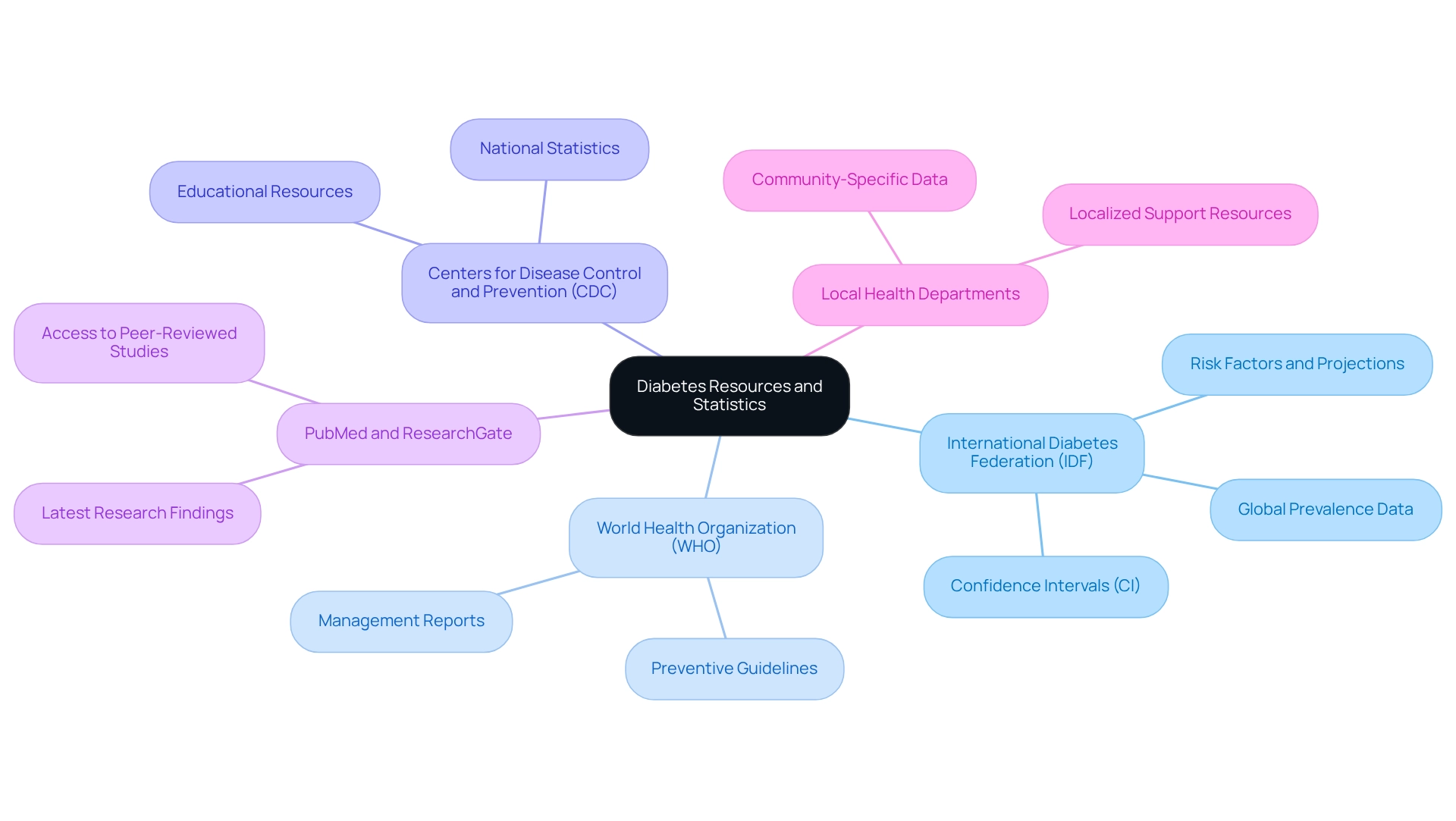Overview
Approximately 830 million people worldwide are living with type 2 diabetes, a condition that accounts for over 90% of all diabetes cases. This number is expected to rise significantly, driven by factors such as urbanization and sedentary lifestyles. It's understandable to feel concerned about these statistics, particularly as we see the prevalence increasing in low- and middle-income countries.
The urgency of this situation cannot be overstated. We need to raise awareness and implement targeted interventions to manage and prevent this chronic condition. You're not alone in this journey; many are facing similar challenges. Together, we can work towards better understanding and addressing the needs of those affected by type 2 diabetes.
If you or someone you know is navigating this diagnosis, know that support is available. We are here to help you every step of the way, providing resources and guidance to empower you in managing your health.
Introduction
The global landscape of Type 2 Diabetes is shifting dramatically, with alarming rates of prevalence that demand our immediate attention. This chronic condition, marked by the body's inability to effectively metabolize glucose, affects millions worldwide, particularly in low- and middle-income countries.
It's important to recognize that over 830 million adults are currently living with this condition, a staggering figure that has quadrupled since 1990, as revealed by the International Diabetes Federation. With projections indicating further increases, understanding the underlying risk factors—from obesity and sedentary lifestyles to genetic predispositions—becomes critical for all of us.
In this article, we will explore the current statistics, delve into the key contributors to rising diabetes rates, and highlight the urgent need for comprehensive education and community support initiatives designed to empower you in managing your health effectively. Remember, you're not alone in this journey; we are here to support you every step of the way.
Define Type 2 Diabetes and Its Global Prevalence
Condition 2 is a chronic ailment that affects the body's ability to process sugar (glucose), an essential energy source. Unlike the first type of diabetes, where insulin production is absent, individuals with the second type either produce insufficient insulin or their cells do not respond effectively to it. This dysfunction can lead to elevated blood sugar levels, which may cause serious health issues if not managed properly.
The global incidence of non-insulin dependent diabetes mellitus is rising at a concerning pace. The International Diabetes Federation (IDF) reports that approximately 11.1% of adults aged 20-79 are living with this condition, raising the question of how many people have type 2 diabetes in the world, as it accounts for over 90% of these cases. This translates to around 830 million individuals worldwide, which reflects how many people have type 2 diabetes in the world, a staggering increase that has quadrupled since 1990. The rise is particularly pronounced in low- and middle-income countries, where limited healthcare resources exacerbate the situation. In Switzerland, the total Disability-Adjusted Life Years (DALY) related to this condition was reported at 89.2 thousand, highlighting the significant health impact of this issue, and recent forecasts suggest that by 2025, it will be crucial to assess how many people have type 2 diabetes in the world, as its prevalence continues to grow driven by urbanization, sedentary lifestyles, and dietary changes. Case studies reveal regional disparities in blood sugar disorder detection, especially in the Western Pacific region, where the IDF emphasizes the need for targeted interventions to improve healthcare access and reduce the high rates of undiagnosed conditions. As Sir Zumla, a UK-NIHR Senior Investigator, notes, despite understanding the primary factors of the condition, its prevalence continues to rise globally, underscoring the urgent need for ongoing research and intervention.
This persistent trend highlights the pressing need for education and community support to empower individuals in managing their health effectively. T2DSolutions is dedicated to addressing these challenges through comprehensive education and community engagement. We provide resources such as dietary plans, exercise routines, and mental health support to ensure that individuals have the tools they need to navigate their health journey. By offering clear, actionable information and fostering a supportive community, T2DSolutions aims to be a reliable partner for those affected by Type 2 and Type 3 conditions. Remember, you're not alone in this journey; we are here to support you every step of the way.

Examine Current Statistics on Type 2 Diabetes Cases Worldwide
Recent studies reveal a dramatic increase in the worldwide occurrence of diabetes, a condition that affects many lives. According to the IDF Diabetes Atlas 2025, over 800 million adults are currently living with diabetes, prompting us to consider how many people have type 2 diabetes in the world, with projections indicating this figure could escalate to 1.3 billion by 2050. The World Health Organization (WHO) highlights a concerning trend, noting how many people have type 2 diabetes in the world, as the occurrence of diabetes among adults surged from 7% in 1990 to 14% in 2022. Alarmingly, nearly 450 million adults are estimated to be living with undiagnosed blood sugar issues. This underscores the urgent need for enhanced awareness and screening initiatives, as it is important to recognize how many people have type 2 diabetes in the world, particularly given the increase in cases that is pronounced in low- and middle-income countries (LMICs), where prevalence is projected to rise by 59.7% between 2021 and 2025. This trend underscores the importance of sustaining a healthy weight, following a nutritious diet, and participating in regular physical activity, especially when considering how many people have type 2 diabetes in the world. These lifestyle modifications can greatly prevent or postpone the development of diabetes. A case study on prevention shows that losing merely 5% to 7% of body weight and dedicating oneself to regular exercise can significantly lower the chance of developing Type 2 diabetes. Notably, women with blood sugar issues who worked out a minimum of four hours weekly had a 40% decreased chance of developing heart disease compared to those who did not exercise. This underscores the essential role of physical activity in managing complications associated with diabetes.
As the international community prepares for forthcoming initiatives, including a crucial UN meeting focused on enhancing health systems and improving care for diabetes, the WHO stresses the importance of aligning efforts towards the 2030 and 2050 objectives. This focus on prevention and management remains critical, reinforcing the call to action for awareness and proactive measures in combating the diabetes epidemic, particularly in light of how many people have type 2 diabetes in the world. T2DSolutions aims to be a vital resource hub for newly diagnosed patients, providing education and support to navigate these challenges effectively. Remember, you are not alone in this journey, and we are here to support you every step of the way.

Identify Key Risk Factors Contributing to Type 2 Diabetes Rates
Many essential factors contribute to the increasing rates of Type 2 Diabetes, influencing how many people have type 2 diabetes in the world, with each factor playing a significant role in the overall prevalence of this condition. At T2DSolutions, we aim to provide resources and support to help individuals manage these risk factors effectively.
-
Obesity: Excess body weight is the most critical risk factor, with a high body mass index (BMI) closely linked to insulin resistance. It's understandable to feel concerned about the connection between obesity and high blood sugar levels, especially as obesity rates continue to rise globally. At T2DSolutions, we offer educational materials and community support to promote healthy weight management strategies. As noted by Ralf Weiskirchen in the International Journal of Molecular Sciences, "The Role of Obesity in 2 Mellitus—An Overview," obesity significantly contributes to the onset of the condition.
-
Physical Inactivity: A sedentary lifestyle greatly heightens the likelihood of developing Type 2 Diabetes. Regular physical activity is essential for maintaining healthy blood sugar levels, and the lack of exercise is a growing concern in many populations. We provide resources to encourage physical activity and connect individuals with local exercise programs, helping you take steps toward a healthier lifestyle.
-
Age: The likelihood of Type 2 Diabetes increases with age, particularly after 45 years. As our population gets older, the occurrence of blood sugar disorders, including how many people have type 2 diabetes in the world, is anticipated to rise, emphasizing the necessity for focused prevention strategies. T2DSolutions is dedicated to informing older adults about their heightened vulnerability and the importance of routine health screenings.
-
Family History: Genetics play a crucial role in the likelihood of developing this condition. If you have a family history of diabetes, you may be at a heightened risk. Awareness and monitoring are vital for at-risk families. We provide guidance on genetic counseling and family health history assessments to support you in navigating this concern.
-
Ethnicity: Certain ethnic communities, such as African Americans, Hispanic Americans, and Native Americans, show a greater tendency to develop Type 2 Diabetes. The occurrence of this condition has notably risen for all racial and ethnic groups from 2002 to 2018, raising concerns about how many people have type 2 diabetes in the world and highlighting the urgency of addressing this issue through culturally specific prevention and education initiatives. T2DSolutions is committed to creating culturally relevant resources to support these communities.
-
Diet: Unhealthy food choices, particularly those high in sugar and harmful fats, significantly contribute to obesity and, consequently, increase the risk of blood sugar complications. Promoting healthier eating habits is essential for reducing the incidence of Type 2 Diabetes. We offer nutritional guidance and cooking classes to help individuals make healthier food choices.
The financial consequences of this condition are significant, with excess medical expenses per person related to the illness rising from $10,179 to $12,022 from 2012 to 2022. Understanding these risk factors is essential for developing effective prevention and early intervention strategies, as it can provide insights into how many people have type 2 diabetes in the world and enable individuals to take proactive steps in managing their health. Moreover, information from the SEARCH for Diabetes in Youth study revealed that during 2017-2018, there were 5,293 new instances of Type 2 Diabetes among U.S. children and adolescents under 20 years, emphasizing the rising occurrence of this condition in younger populations. At T2DSolutions, we are committed to addressing these challenges through education, support, and community engagement. You're not alone in this journey; we are here to support you every step of the way.

Utilize Resources for Tracking and Understanding Diabetes Statistics
Staying informed about how many people have type 2 diabetes in the world, along with the latest statistics and trends, is crucial, and utilizing reliable resources can provide the comprehensive data and insights you need. At T2DSolutions, we aim to be your central hub for education on this condition, gathering key resources from reputable organizations, including:
- International Diabetes Federation (IDF): The IDF Atlas offers extensive data on prevalence, risk factors, and future projections, making it an essential tool for understanding global trends. Notably, the Atlas includes confidence intervals (CI) for population estimates, which indicate the reliability of the data presented, including information on how many people have type 2 diabetes in the world.
- The World Health Organization (WHO) publishes reports and guidelines focused on managing and preventing this condition, offering evidence-based recommendations for healthcare providers and patients alike.
- The Centers for Disease Control and Prevention (CDC) provides national statistics and educational resources aimed at prevention, empowering individuals and communities to address this growing health concern.
- PubMed and ResearchGate grant access to peer-reviewed studies and articles, ensuring that you can explore the latest research findings in the care and management of this condition.
- Many local health departments offer community-specific data and resources tailored to management, fostering a localized understanding and support.
By leveraging these resources through T2DSolutions, you, along with healthcare providers and policymakers, can gain a clearer picture of the landscape, enabling informed decisions regarding prevention and management strategies. It’s important to note that by 2025, around 97.6 million Americans aged 18 and above are projected to have prediabetes. This emphasizes the urgent need for effective education and intervention regarding this condition.
Moreover, it’s reassuring to recognize that women experiencing high blood sugar who engage in physical activity for at least four hours a week have a 40% reduced risk of developing heart disease. This highlights the significance of lifestyle modifications in managing health. However, it’s also crucial to be aware that unmanaged insulin-dependent conditions can lead to severe issues like diabetic ketoacidosis, underscoring the necessity for careful attention and management, especially in light of how many people have type 2 diabetes in the world. The rising incidence of Type 1 and Type 2 diabetes among youth calls for urgent public health strategies to address diabetes prevention and management in younger populations. Remember, you're not alone in this journey. We are here to support you every step of the way.

Conclusion
The alarming rise in Type 2 Diabetes cases globally highlights the urgent need to address this chronic condition that affects millions. With over 830 million adults currently living with diabetes and projections indicating further increases—especially in low- and middle-income countries—it’s crucial to understand the key risk factors contributing to this epidemic. Factors such as obesity, physical inactivity, age, family history, ethnicity, and poor dietary choices significantly impact the rising prevalence of diabetes. This reality underscores the necessity for targeted prevention and intervention strategies.
Education and community support are vital components in the fight against diabetes. Initiatives like T2DSolutions aim to empower individuals by providing resources that promote healthy lifestyles. These include nutritional guidance, exercise programs, and mental health support. By fostering a supportive environment and offering actionable information, communities can effectively combat the challenges posed by Type 2 Diabetes.
As we continue to confront this pressing health issue together, it is essential to leverage reliable resources and data to inform our strategies for prevention and management. Organizations such as the International Diabetes Federation and the World Health Organization provide critical insights that can guide individuals, healthcare providers, and policymakers in creating effective interventions. With collective efforts focused on education, awareness, and lifestyle changes, there is hope for a healthier future. Remember, you’re not alone in this journey, and together, we can significantly mitigate the impacts of Type 2 Diabetes.
Frequently Asked Questions
What is Condition 2, and how does it affect the body?
Condition 2, also known as type 2 diabetes, is a chronic ailment that affects the body's ability to process sugar (glucose). Individuals with this condition either produce insufficient insulin or their cells do not respond effectively to insulin, leading to elevated blood sugar levels.
What is the global incidence of type 2 diabetes?
Approximately 11.1% of adults aged 20-79 are living with type 2 diabetes, accounting for over 90% of diabetes cases worldwide. This translates to around 830 million individuals, a number that has quadrupled since 1990, with a significant rise particularly in low- and middle-income countries.
What are the health impacts of type 2 diabetes?
If not managed properly, elevated blood sugar levels associated with type 2 diabetes can lead to serious health issues. In Switzerland, the total Disability-Adjusted Life Years (DALY) related to this condition was reported at 89.2 thousand, indicating a significant health impact.
What are the factors contributing to the rising prevalence of type 2 diabetes?
The rise in type 2 diabetes prevalence is driven by urbanization, sedentary lifestyles, and dietary changes. There are also regional disparities in blood sugar disorder detection, particularly in the Western Pacific region, highlighting the need for targeted healthcare interventions.
What is the role of T2DSolutions in addressing type 2 diabetes?
T2DSolutions is dedicated to providing education and community support to empower individuals in managing their health. They offer resources such as dietary plans, exercise routines, and mental health support to help individuals navigate their health journey effectively.
How can individuals access support for managing type 2 diabetes?
Individuals can access support through T2DSolutions, which provides comprehensive education and community engagement to ensure that those affected by type 2 diabetes have the necessary tools and information to manage their condition.



